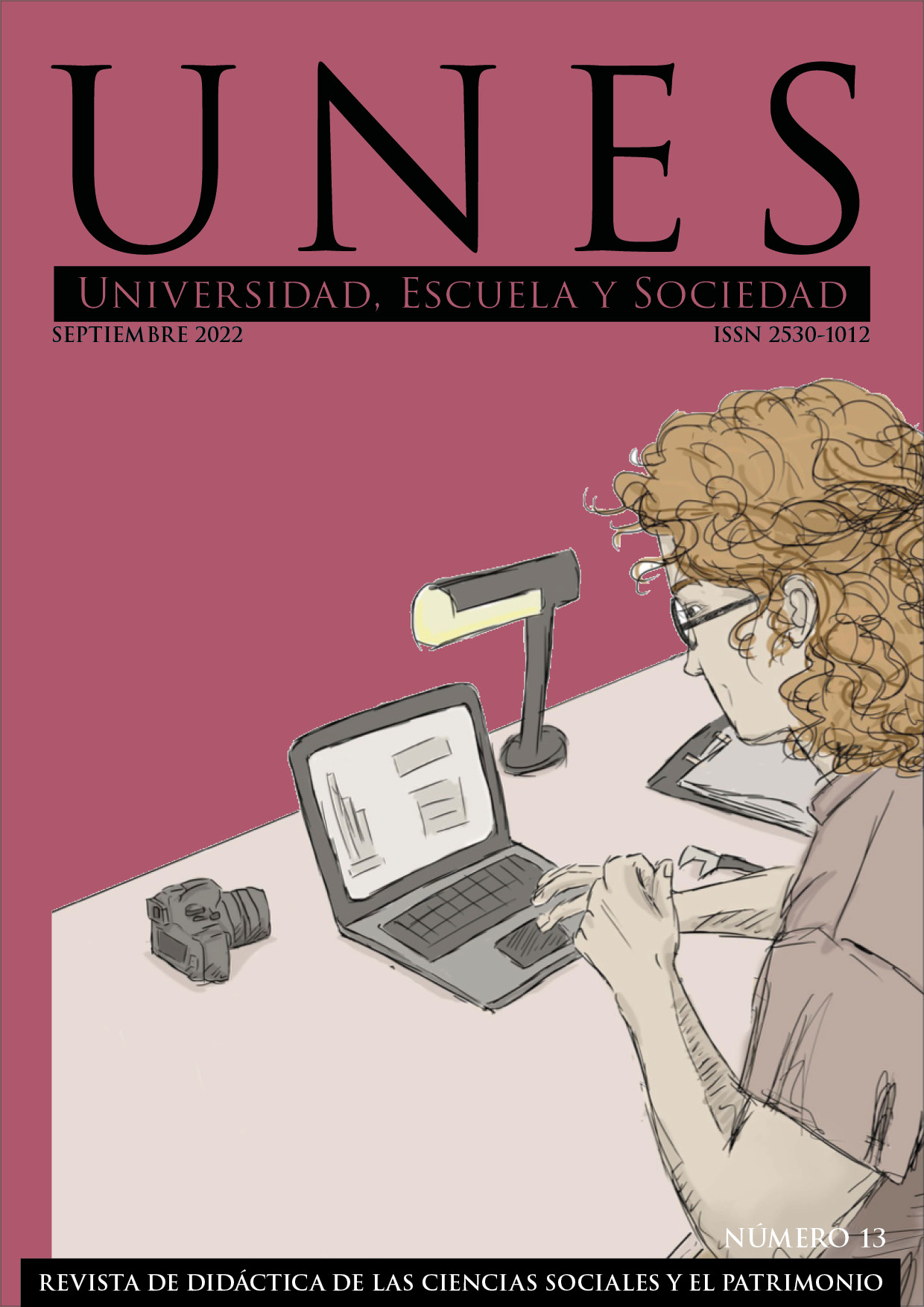Researching and Creating: The Creativity and the Work with Historical Sources as a Way to Develop Historical Thinking in the Classroom
DOI:
https://doi.org/10.30827/unes.i13.25396Keywords:
historical thinking; historical sources; creative learning; active and participatory learningAbstract
On the basis of the predominant presence of rote memory and conceptual contents in the History education, in this paper we make an educational proposal to develop the historical thinking in the classroom by means of the work with historical sources and the encouragement of the creative learning. The principal core of this proposal is the elaboration of a research project in a group. Through this project the students will delve into some historical aspects of the past by the study of historical sources of the period and they will materialise their research in an original work of literary, artistic, musical or audiovisual nature. The methodology employ in this proposal bases upon the creative learning and the active and participatory learning. With its application we want that the students develop procedural skills to study and value by themselves the past. Additionally, we intend to encourage the creativity in the classroom, with the objective that the students explore other personal expressions and they make connexions with other disciplines and academic and personal experiences. The educational proposal that we present in the following lines has been designed for the study of the Second World War. This content is taught in the subject Historia del Mundo Contemporáneo, in the first course of the Bachillerato en Humanidades y Ciencias Sociales, but the proposal can be adapted to other historical periods and educational levels.
Downloads
References
Aubert, A., García C. y Racionero, S. (2014). El aprendizaje dialógico. Cultura y Educación, 21(2), 129-139. https://www.tandfonline.com/doi/abs/10.1174/113564009788345826
Bécares L., Busto, M., y de Hoyos, C. (2016). Sentarse, escuchar y repetir. ¿Existe otra forma de enseñar historia? IKASTORRATZA. e-Revista de Didáctica, 16, 15-38. http://www.ehu.es/ikastorratza/16_alea/2.pdf
Bueno, D. (2019). Creatividad y cerebro. En P. Tudela-Caño y P. Paraja-García (coords.), El arte de educar creativamente (pp. 49-58). Litografía Gráficas Sabater S. L.
Cooper, H. (2013). Why must teaching and learning in History be creative? En H. Cooper (ed.), Teaching History Creatively (pp. 3-18). Routledge.
Felices-de la Fuente, M. M. y Chaparro-Sainz, A. (2020). Pensar históricamente a través del uso de fuentes primarias. Un estudio en la formación inicial del profesorado. En M. E. Cambil-Hernández, F. de Oliveira, A. R. Fernández-Paradas, G. Romero-Sánchez y A. José-Ruiz (coords.), Nuevas tendencias en investigación e innovación en didáctica de la historia, patrimonio cultural y memoria. Proyección educativa (pp. 95-107). Universidad de Granada.
Fernández, L., Gómez, M.A., Guerrero, D., Lázpita, A., López, C., Morillas, J. J. y Sánchez, G. (2015). Hacer posible lo contrario. Enseñar y aprender de otra manera. Servicio de Publicaciones de la Delegación Territorial de Educación, Cultura y Deporte. https://equipotecnicoorientaciongranada.files.wordpress.com/2014/11/hacerposiblelocontrario.pdf
Ferreras, R. (2019). La educación es una práctica creativa. En P. Tudela-Caño y P. Paraja-García (coords.), El arte de educar creativamente (pp. 139-155). Litografía Gráficas Sabater S. L.
Gómez-Carrasco, C. J. y Prieto-Prieto, J. A. (2016). Fuentes primarias, objetos y artefactos en la interpretación de la historia. Diseño y evaluación de un taller de numismática en Educación Secundaria. Revista Didáctica de las Ciencias Experimentales y Sociales, 31. https://ojs.uv.es/index.php/dces/article/view/8228
Gómez-Carrasco, C. J. y García-González, F. (2019). Representaciones sociales y la construcción de discursos estereotipados en la enseñanza de la Historia. Un análisis a partir del campesinado (ss. XVI-XVIII). Historia y comunicación social, 24(1), 127-145. http://dx.doi.org/10.5209/HICS.64484
Gómez-Carrasco, C. J. y Miralles-Martínez, P. (2017). Los espejos de Clío. Usos y abusos de la historia en el ámbito escolar. Sílex.
Mitjáns-Martínez, A. (2013). Aprendizaje creativo: Desafíos para la práctica pedagógica. Revista CS, 11, 311-341.
Prieto, J. A, Gómez, C. J. y Miralles, P. (2013). El uso de fuentes primarias en el aula y el desarrollo del pensamiento histórico y social. Una experiencia en Bachillerato. Clío, 39. http://clio.rediris.es/n39/articulos/historiasocial/PrietoGomezMiralles.pdf
Pujolàs, P. (2002). El aprendizaje cooperativo. Algunas propuestas para organizar de forma cooperativa el aprendizaje en el aula. Documento de trabajo. Laboratorio de Psicopedagogía. Universidad de Vic. https://www.ugr.es/~fjjrios/pce/media/7a-AprendizajeCooperativoAula.pdf
Sánchez-Andújar, I. M. (2022). Canta, relata o representa la II Guerra Mundial. Investigar y crear: Una Unidad Didáctica sobre la II Guerra Mundial en el Bachillerato de Humanidades y Ciencias Sociales [Trabajo Fin de Máster]. Universidad de Granada.
Sánchez-Ibáñez, R. y Álvarez-Martínez-Iglesias, J. M. (2019). El uso de las fuentes en los manuales de Historia en el Bachillerato en España. Historia y espacio, 15(53), 145-166. https://historiayespacio.univalle.edu.co/index.php/historia_y_espacio/article/view/8654
Santisteban-Fernández, A. (2010). La formación de competencias de pensamiento histórico. Clío & Asociados, 14, 34-56. https://bibliotecavirtual.unl.edu.ar/publicaciones/index.php/ClioyAsociados/article/view/1674
Downloads
Published
How to Cite
Issue
Section
License
Copyright (c) 2022 Isabel María Sánchez Andújar

This work is licensed under a Creative Commons Attribution-NonCommercial-ShareAlike 4.0 International License.
Authors being published in this journal agree to the following terms:
The authors retain their copyrights but guarantee the journal's right to be the first publisher of the work, licensed under a Creative Commons Attribution-NonCommercial-ShareAlike 4.0 International license, which allows others to share the work, provided that they acknowledge its authorship and initial publication in this journal.
Authors may separately subscribe additional agreements for the non-exclusive distribution of the work published in the journal (for example, including it in an institutional repository or publishing it in a book), with recognition of its initial publication in this journal.
Authors are allowed and encouraged to disseminate their work electronically (for example, in institutional repositories or on their own websites) before and during the submission process, as this may result in productive exchanges, as well as more and earlier citations of the works to be published (See The Effect of Open Access) (in English).






 ISSN-e: 2530-1012
ISSN-e: 2530-1012









